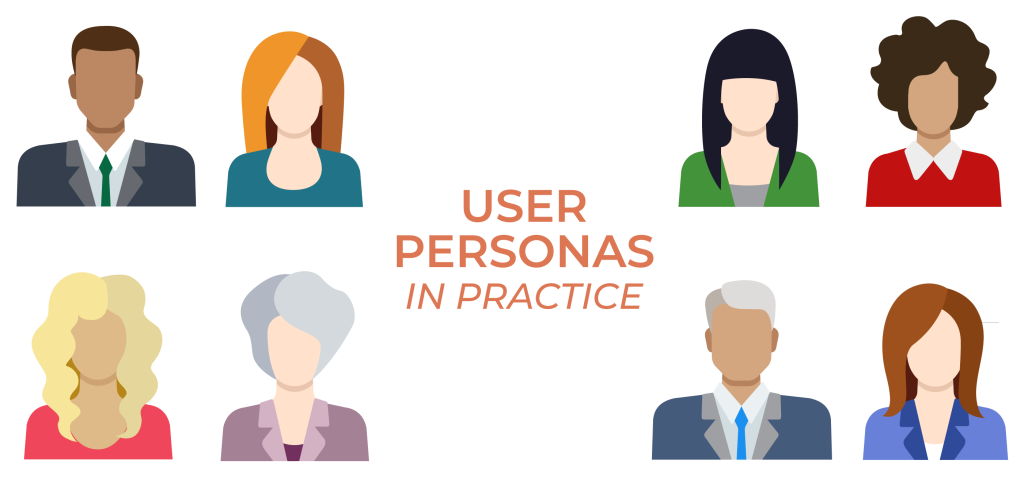
Did you know that the creators of the apps you use, the software you utilize, the websites you visit, the services you make use of, the products you love, and more have you in mind? Yes, you! Your demographics, behaviors, goals, motivations, pain points, everything that defines who you are as an individual in relation to their product or service. They’ve even gone as far as giving you a nickname and an archetype. Based on characteristics they have observed, you could be called “The Computer Nerd,” “The Influencer,” “The Solution Seeker,” or “The Planner.” One way or another, you fit into a category they have developed, called a persona.
User Personas Explained
In user-centered design and marketing, a persona is a profile created to encapsulate user-related research. Nielsen Norman Group explains that “user personas are fictitious yet realistic representations of your target users. They act as a multipurpose tool used to drive many important product development tasks. Created out of complex user data, personas take on a format that is meaningful and creates user empathy among your development team, ensuring your users are always the focus of your efforts.”
After researching and becoming familiar with the users of a particular product or service, marketers and user-experience professionals craft personas, grouping kindred users within one specific profile. The result is a handful of model personas that user researchers and designers can keep in mind while modifying and improving their product or service. Having a name, a face, and various descriptors, each persona resembles a single human user while representing a larger group of users.
Persona Worksheets
Completing a persona worksheet is a great way to organize user research and develop a persona. There are countless examples of persona worksheets utilized today, but many of them are comprised of similar sections. Altogether, all persona worksheets achieve the same goal.
I recently completed a website analysis exercise on two open-source stock imagery websites, Pexels and Unsplash. To gain an understanding of the persona creation process, I downloaded the persona worksheet pictured below and created two persona profiles. I chose to create these profiles for Pexels because Pexels offers stock imagery and footage. Pexels’s inclusion of footage likely draws more diverse users to their site and app. With this knowledge, I felt this was a good way to practice developing personas with different goals and motivations. Although they may be related, I desired for my personas to be distinct. Following are my first Pexels Personas: Sola, the Driven Designer, and Josh, the Independent Videographer.
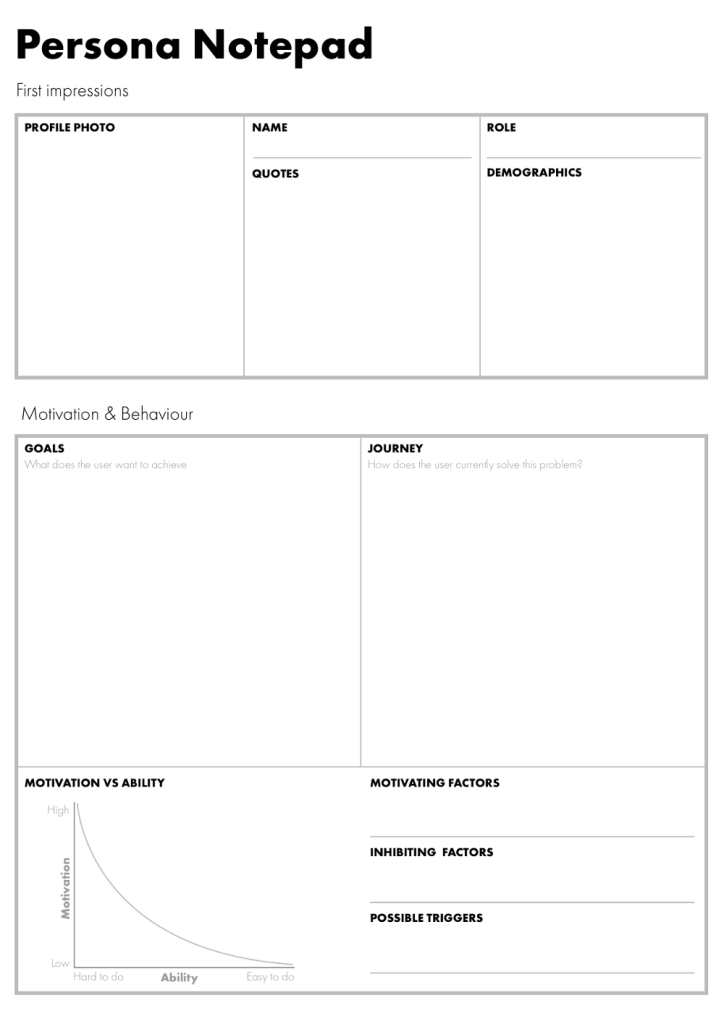
Pexels Persona: Driven Designer
To begin the persona creation process, I thought about myself. To understand my behavior, I needed to practice a little self-searching. Asking questions like, “why do I use Pexels?,” “what am I looking for?,” and “what do I need?” assisted me in identifying my goals, motivating factors, inhibiting factors, and possible triggers. While it took some time to get accustomed to viewing myself objectively, determining my motivation and behavior opened the doorway to pinpointing my influencers and environment.
My first persona, modeled after myself, is a Driven Designer. This user primarily seeks imagery to include in design projects. She has access to other sources of stock imagery and can also utilize photos she already has the rights to that were taken in-house or used in previous design projects. However, this individual uses Pexels to find unique images swiftly.
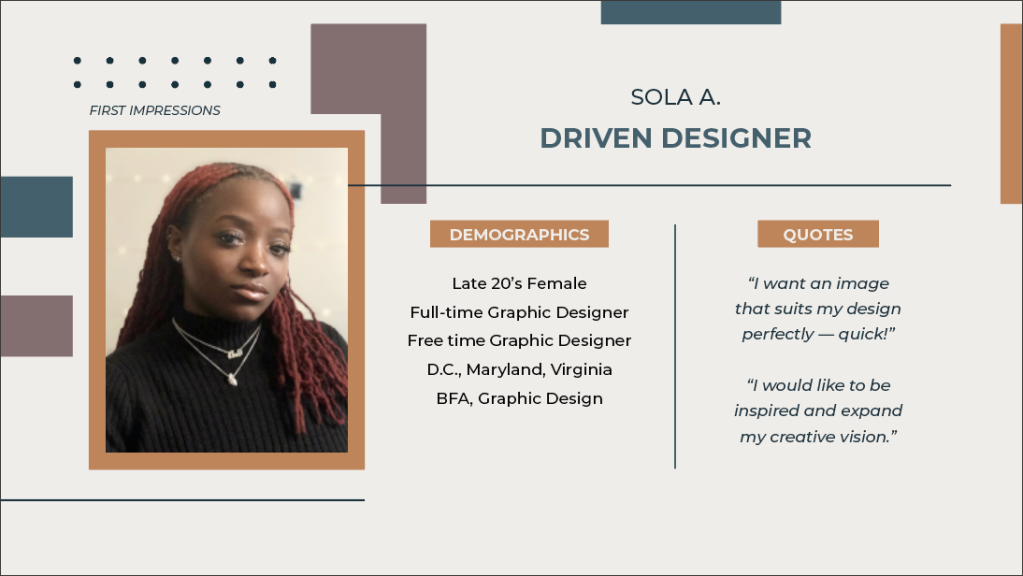
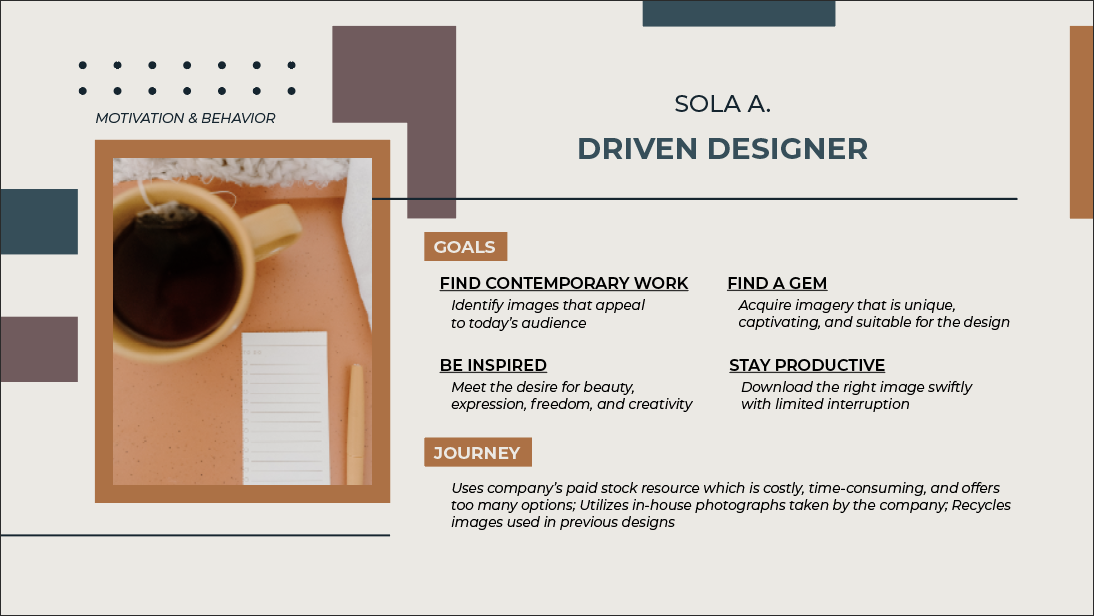
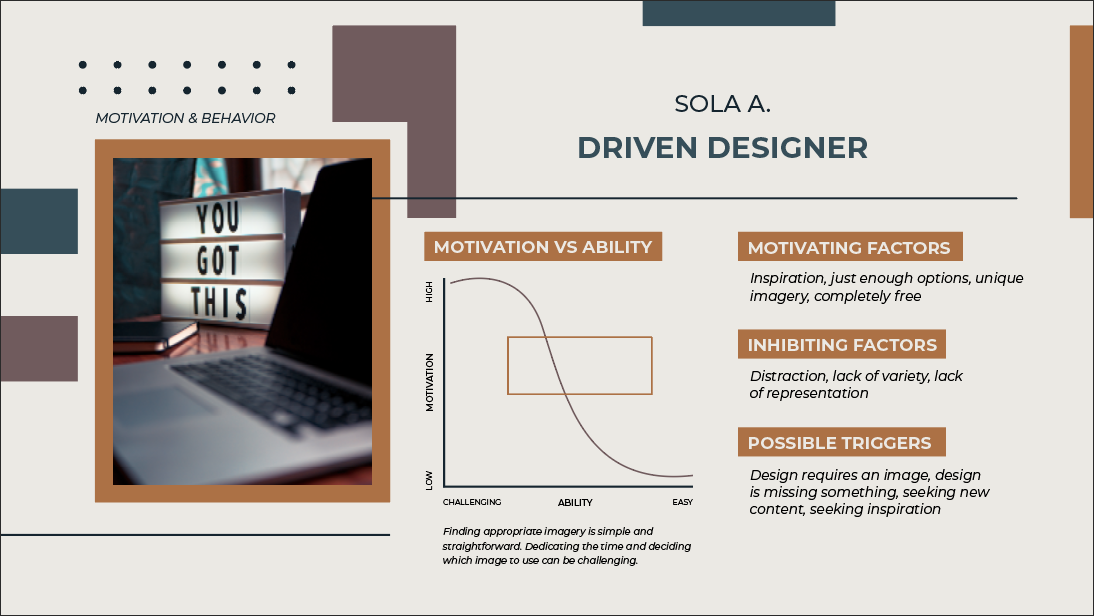
Pictured above: The first two sections of the Driven Designer’s user persona. “First Impressions” encompasses her demographics and direct quotes. “Motivation & Behavior” covers her goals, current journey, motivations, inhibiting factors, and possible triggers.
Search results of her company’s paid stock imagery site contain an innumerable amount of options, making it difficult for her to find a relevant and relatable image that aligns with her vision or narrow down the endless possibilities the site offers. Searching her organization’s in-house photography may limit her because some of the photos may be targeted, outdated, overused, or unsuitable for her current project. She’s also looking for that special spark – a contemporary image that is captivating and meets her needs for creativity and beauty within her design.
Pexels helps her achieve her goals by offering just enough choices and maintaining an eccentric feel. Furthermore, Pexels is completely free. If she downloads an image and later decides not to incorporate it into her design, she’s guilt-free. If she downloads multiple images, it does not impact her or her company’s budget.
To find out more about the Driven Designer, download the full persona.
Pexels Persona: Independent Videographer
My second persona embodies some of the people I have encountered in my field. Unlike my first persona, this persona is more straightforward with fewer underlying goals and motivations. However, this persona was much more challenging to develop because I had to contact other people, reflect on some of my colleagues, brainstorm, and research online. Some of my searches included questions like, “Why do people need stock footage?,” and “Who uses stock footage?” I found that stock footage is often sought after for space-filler content. Enter Josh, the Independent Videographer.
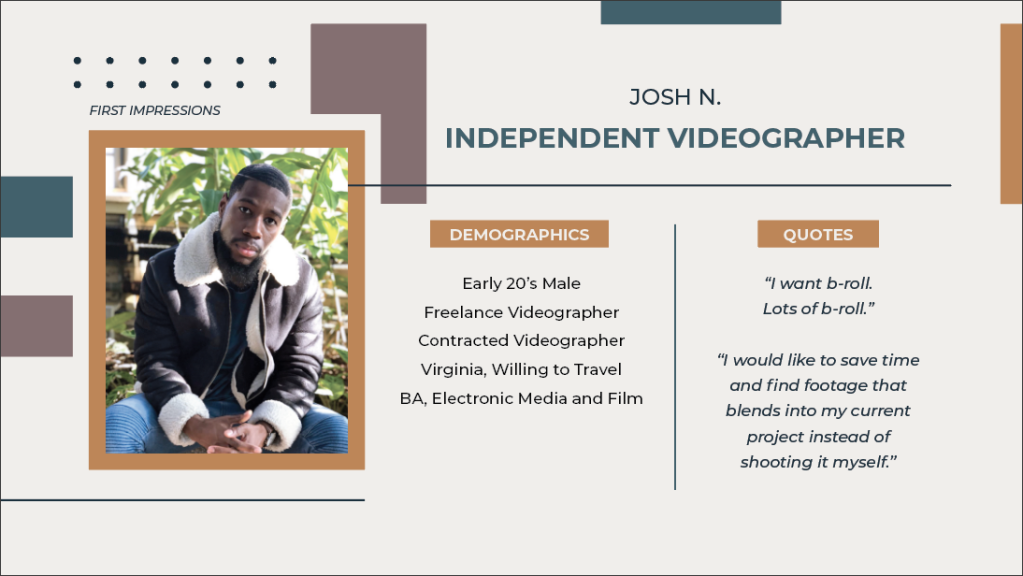
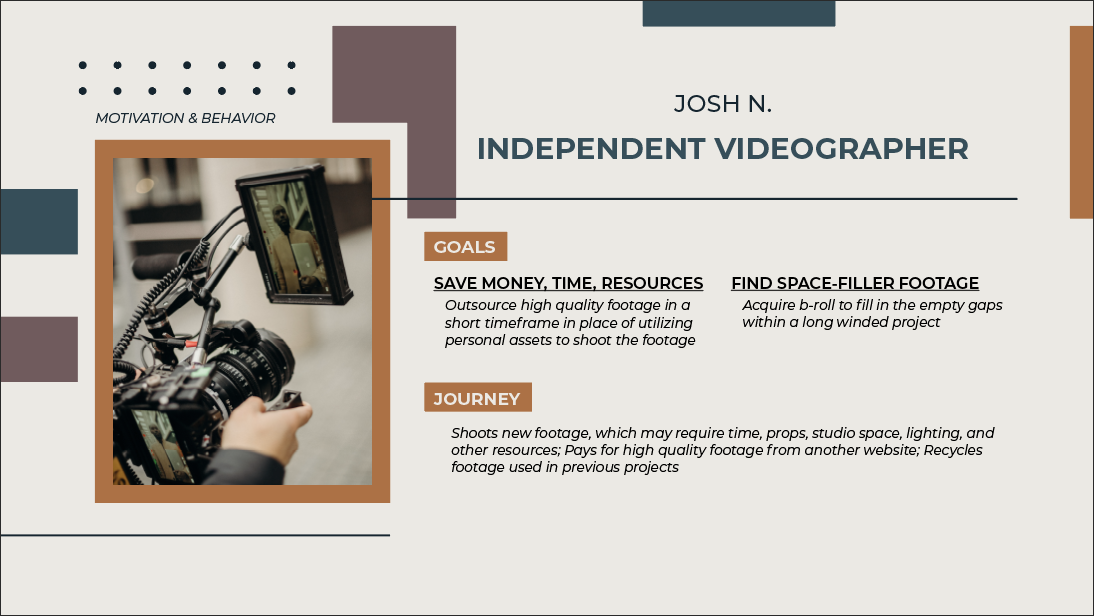
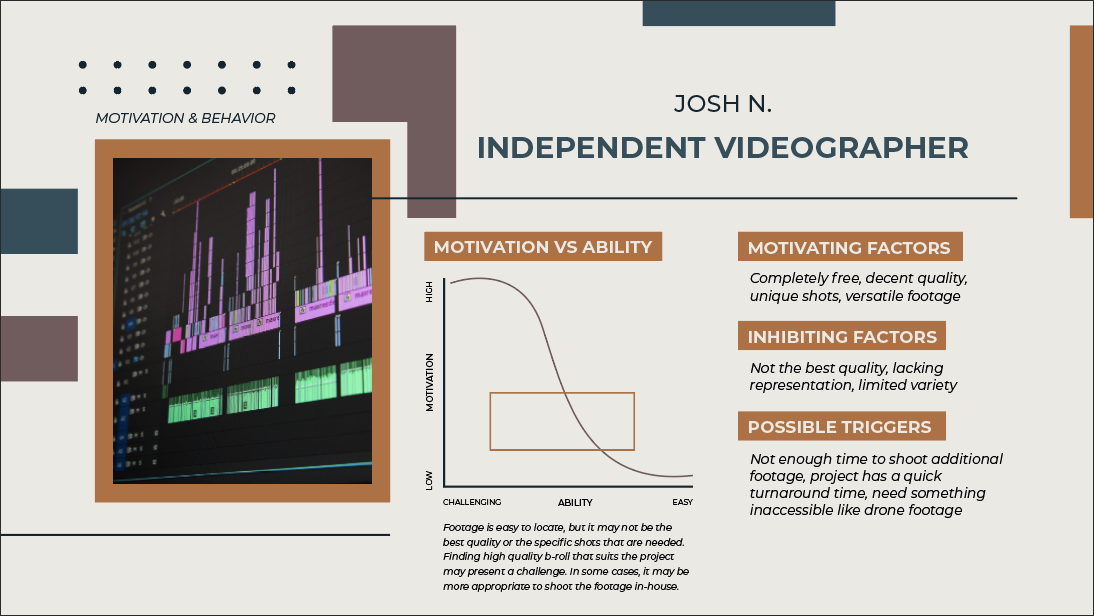
Pictured above: The first couple sections of the Independent Videographer’s user persona. “First Impressions” covers demographics and direct quotes. “Motivation & Behavior” covers his goals, current journey, motivations, inhibiting factors, and possible triggers.
This user searches Pexels for stock footage to fulfill his goals of saving time, money, and resources and finding b-roll. He uses Pexels less often than the Driven Designer because most of his shots are preplanned. However, mid-project, he may find that something is missing, especially if the project is lengthy, warranting dynamic shots. At this point, this individual considers outsourcing footage to keep pace with his deadlines instead of putting effort into shooting new footage, which may require time, money, props, studio space, lighting, subjects, specific equipment, and more. Josh is seeking high-quality footage that he can toss into his current project timeline for a few seconds without hesitating. His relationship with Pexels is a hit-or-miss affair because there are no workarounds for the footage blending with the project, capturing his intended shots, or sustaining the quality he needs.
For more insight on the Independent Videographer, download the full persona.
Final Thoughts
You may have never thought about it before, but you likely bear a resemblance to “Nerdy Nancy,” “Focused Fred,” or another persona, developed by the user experience researchers and designers of your favorite products and services. Classifying you within a persona helps user experience professionals keep you at the forefront of their minds. It helps them remember what makes your experience significant, matters to you most, and keeps you coming back. Developing and utilizing user personas is yet another way to practice empathy in user experience design.
[…] this exercise, I returned to my website analysis exercise, choosing to create personas for Pexels users. Following a persona worksheet, I first created a persona for myself, the Driven Designer. I […]
LikeLike